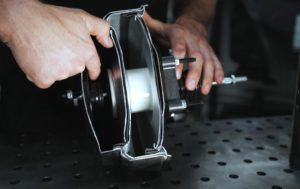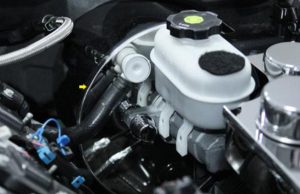Upgrading a car’s performance is an exciting process — bigger turbos, improved suspension, and powerful engines all make for a thrilling drive. But with more speed comes greater responsibility, especially when it comes to braking. One often-overlooked component that can make or break your braking system is the brake booster.
If you’ve increased your car’s horsepower, changed to larger brake calipers, or converted to an aftermarket braking system, your stock brake booster may no longer provide the assistance needed for optimal control. In this guide, we’ll explore when and why to upgrade your brake booster, the performance benefits it brings, and how to choose the right one for your setup.
What Does a Brake Booster Do?

A brake booster amplifies the force applied to the brake pedal using vacuum or hydraulic pressure, allowing the driver to stop the car with minimal physical effort.
Without sufficient assist from the booster, braking can feel stiff, delayed, or inconsistent, especially under high-performance conditions.
| Type of Brake Booster | How It Works | Common Use |
|---|---|---|
| Vacuum Brake Booster | Uses engine vacuum to assist pedal pressure. | Gasoline engines. |
| Hydraulic (Hydro-Boost) | Uses power steering hydraulic pressure. | Diesel and heavy-duty vehicles. |
| Electric Brake Booster | Uses an electric pump to create pressure. | EVs and modern performance cars. |
Why Performance Cars May Need an Upgrade
When you modify your vehicle for higher performance, every system must adapt — including brakes. Here’s why your stock brake booster might not be enough:
-
Higher Speed = Greater Braking Demand
Performance upgrades increase acceleration, but also raise the energy that brakes must dissipate during deceleration. A stock booster may not provide enough assist for aggressive braking. -
Larger Brake Calipers or Multi-Piston Systems
Aftermarket calipers require more fluid volume and pressure to operate efficiently, which puts more strain on your existing booster and master cylinder. -
Low Vacuum in Turbocharged or Cammed Engines
Modified engines often generate less manifold vacuum, reducing the effectiveness of vacuum boosters. In such cases, a hydro-boost or electric booster is a better option. -
Track or Competition Use
Repeated hard braking during track driving can expose weaknesses in the factory booster, causing pedal fade or inconsistent feel. -
Pedal Feel and Modulation
A performance booster provides improved pedal feedback and control, which is essential when braking at the limit.
Key Signs It’s Time to Upgrade Your Brake Booster
Here are the most common indicators that your brake booster no longer meets your braking demands:
-
The pedal feels too hard, requiring excessive effort.
-
Braking distance has increased despite healthy pads and rotors.
-
You hear a hissing noise or experience inconsistent assist.
-
The pedal feel changes when the engine is off versus on.
-
You’ve upgraded your brake calipers, master cylinder, or turbo setup.
If one or more of these apply, it’s time to consider an upgraded unit.
Choosing the Right Brake Booster for Performance Applications
When selecting an upgraded brake booster, it’s crucial to match the type and size to your system’s requirements.
| Booster Type | Best For | Advantages | Considerations |
|---|---|---|---|
| Large-Diameter Vacuum Booster | Mild street upgrades | Strong assist, affordable | Needs adequate vacuum from engine |
| Dual-Diaphragm Booster | Turbocharged or cammed engines | More assist from less vacuum | Slightly larger housing |
| Hydro-Boost System | High-performance or heavy vehicles | Works independently of engine vacuum | Requires hydraulic plumbing |
| Electric Brake Booster | Modern conversions, EVs, track builds | Consistent pressure, compact design | More complex installation |
Performance Benefits of a Brake Booster Upgrade
Upgrading your brake booster can dramatically improve both safety and driving experience.
1. Enhanced Braking Power
A high-performance booster increases assist pressure, giving stronger, more predictable stops with less pedal effort.
2. Improved Pedal Feel and Modulation
You gain a firmer, more responsive pedal, allowing precise brake control — especially crucial in track or spirited driving.
3. Better Compatibility with Aftermarket Systems
When paired with big brake kits or performance master cylinders, the right booster ensures balanced brake pressure across all wheels.
4. Reduced Brake Fade
In high-heat or repeated braking scenarios, an upgraded booster helps maintain consistent stopping performance.
Comparison: Stock vs. Performance Brake Booster
| Feature | Stock Booster | Performance Booster |
|---|---|---|
| Brake Assist | Moderate | High and consistent |
| Pedal Feel | Softer, less precise | Firm and responsive |
| Vacuum Dependence | High | Adjustable or independent |
| Ideal Use | Daily driving | High-speed or track use |
| Durability | Standard materials | Reinforced, heat-resistant design |
Installation Tips & Compatibility
Before upgrading your booster, consider these steps for a smooth and effective installation:
-
Check Compatibility — Ensure your new booster matches your master cylinder and brake line fittings.
-
Inspect Vacuum Lines or Hydraulic Lines — Replace any cracked hoses or weak fittings.
-
Adjust Pedal Ratio — Performance boosters may require minor adjustments for ideal pedal travel.
-
Bleed the System — Always remove air from the brake lines after installation.
-
Test Under Load — Verify pedal response and stopping distance in a safe environment before aggressive driving.
For reliable, OEM-quality replacements or performance-grade boosters, you can Buy Brake Booster online and find options suited to your specific vehicle.
Practical Scenarios: When Upgrading Makes Sense
| Scenario | Stock Booster Issue | Recommended Upgrade |
|---|---|---|
| Turbocharged engine with low vacuum | Inadequate assist | Dual-diaphragm or hydro-boost |
| Big brake kit installed | Weak braking response | Performance vacuum or hydro-boost |
| Track/race driving | Pedal fade at high heat | Electric or hydraulic booster |
| Diesel vehicle | No engine vacuum | Hydro-boost system |
Maintenance and Safety After Upgrade

Once your performance booster is installed, proper maintenance is key:
-
Inspect hoses and seals every 10,000–15,000 km.
-
Check vacuum source or hydraulic pressure periodically.
-
Use high-quality brake fluid to prevent corrosion and seal failure.
-
Listen for hissing sounds, which can indicate leaks.
-
Never ignore changes in pedal resistance or braking performance.
Conclusion
Your brake system is only as strong as its weakest component. In high-performance or modified vehicles, the brake booster plays a crucial role in maintaining safe, responsive braking under demanding conditions.
If your car is tuned, equipped with bigger brakes, or frequently driven hard, it’s time to evaluate whether your stock booster can keep up. Upgrading ensures that your braking power matches your engine’s potential — delivering confidence, control, and shorter stopping distances.
Don’t compromise on safety or performance — make sure your vehicle stops as well as it goes. You can Buy Brake Booster online to find the perfect fit for your performance setup and ensure consistent braking